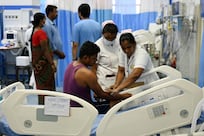Ben Flanagan
The ad man Kevin Roberts has certainly made people mad – and the global storm he started over industry sexism is being felt just as strongly in the Middle East.
Mr Roberts this month resigned from his role as the chairman of Saatchi & Saatchi after making controversial claims that the debate over gender bias is over and that women in the advertising industry lack “vertical ambition”.
His words reminded some of the testosterone-fuelled era of Don Draper, the fictional star of the famous TV show Mad Men, which was largely set in the 1960s.
But Mr Roberts’ claims were all the more incendiary given that – despite the passing decades – all the statistics suggest there are still many more Mad Men than women holding senior roles.
Take the findings of an initiative called the 3% Conference – so-called because only 3 per cent of all creative directors in the US were women when it was established in 2010. The movement’s latest report, published in March this year, found that women are still not making it to the top, with just 11 percent of creative directors being female, despite women making up 46.4 percent of the overall industry.
Advertising executives in the UAE say it’s a similar story in the Arab world – with much work needed to close the gender gap.
Elie Khouri, the chief executive of the Omnicom Media Group in the Middle East and North Africa, said there were no statistics available about the representation of women in this region – but acknowledged there was a problem in the industry as a whole.
"We have a long way to go," he told The National. "We have two extreme markets like Lebanon and Egypt where we have a relatively fair representation for women. Dubai sits somewhere in the middle. Saudi Arabia is the other extreme, for obvious reasons."
The executive said that women currently make up 28 percent of Omnicom Media Group’s regional leadership team, including that of its individual agencies. And the group is working towards an equal balance of men and women in senior roles by 2020.
Addressing the “diversity and inclusion problem” in the industry is very much a business-orientated concern as well as being the right thing to do, Mr Khouri added.
“Given the fact that women make up to 85 per cent of purchase decisions, the reason we need to have women represented at every level of our industry is plainly obvious,” Mr Khouri wrote in a LinkedIn post.
One of the most prominent women in the Middle East advertising business is Elda Choucair, the UAE managing director at PHD, a media buying network that is part of Omnicom Media Group.
Ms Choucair said she disagreed with the claim made by Mr Roberts that women lack the drive to climb the career ladder and have instead a “circular ambition to be happy”.
She said: “I don’t think it’s lack of ambition that is causing fewer women to be in leadership positions. … There’s a deeper question as to whether there is an environment that is set up to help women reach their ambitions. Is this environment there or not? This is the question.”
Ms Choucair said that while there may be a gender gap in the wider Middle East advertising world, at her own company four of eight senior director positions are filled by women.
“I’ve been lucky and fortunate to be working with people who appreciate merit and hard work,” Ms Choucair said.
Ramzi Raad, the group chairman of the TBWARAAD, which is headquartered in Dubai, said that many of the advertising agency’s campaigns have been led by female creative directors.
These include work for the Royal Opera House in Muscat, the Dubai At Its Best campaign for the Dubai Shopping Festival, and the award-winning VIP Fridge Magnet concept for Red Tomato Pizza, in which customers placed orders simply by pushing a button on a box that links to the internet.
Mr Raad said 52 per cent of the staff at his agency’s creative hub in Beirut are women. But the wider industry lacks “badly needed gender equality”, Mr Raad noted.
Equal representation of women on senior management teams is the exception rather than the rule, other commentators say.
Austyn Allison, the editor of Campaign Middle East, a Dubai-based magazine covering the advertising industry, said that the UAE advertising industry is “dominated by men”.
But senior positions held by women such as Ms Choucair, as well as those further down the management ladder, show that there is “light in the darkness”, he said.
“Female creatives are putting out some of the best work in the region, although many of these are working for independent agencies, often in high positions. This could be seen as a tribute to entrepreneurship, or more pessimistically as a way to sidestep the glass ceilings of big-name international networks,” Mr Allison said.
“The industry has a gender imbalance and it knows it. It says it is working to fix it, and the talent is certainly there. But we will have to wait and see whether the abundance of talented women working in creative and media agencies will be able to rise to the top as the industry grows and develops.”
business@thenational.ae





